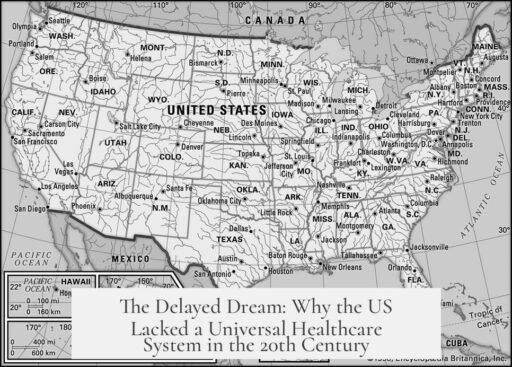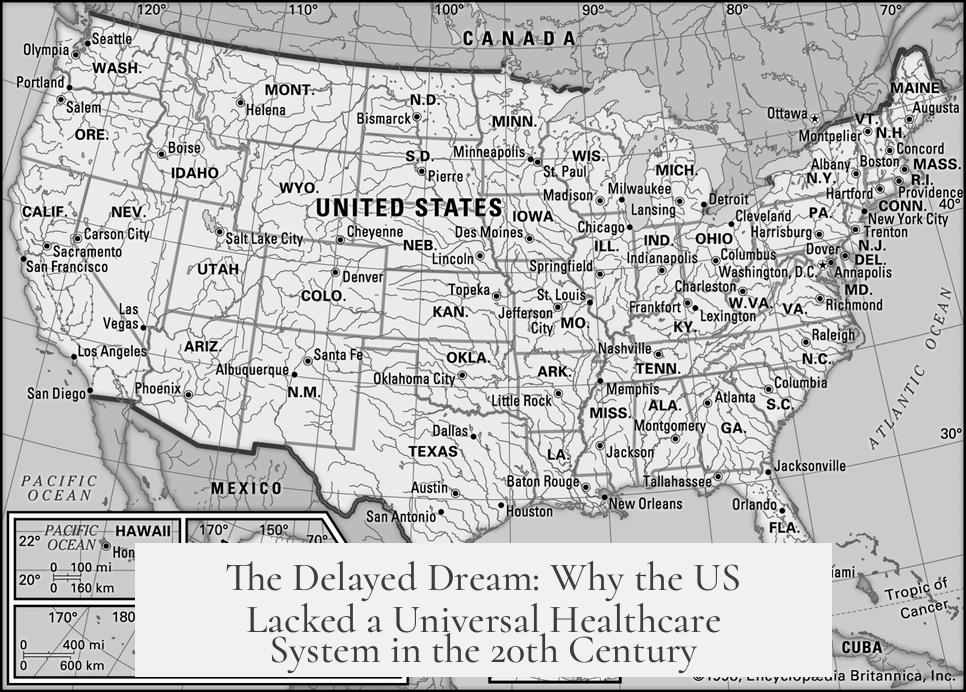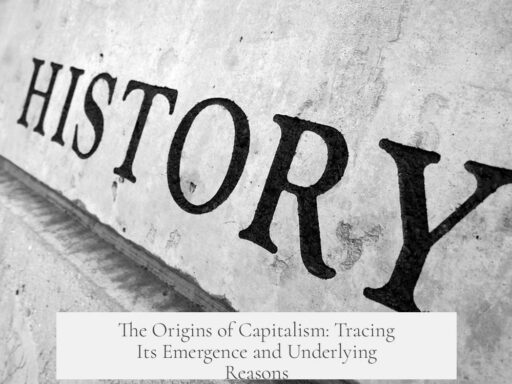The United States did not establish a universal healthcare system during the 20th century, unlike many liberal democracies, due to a mix of historical, political, structural, and cultural factors. These included early political setbacks, federalism challenges, the rise of employer-based private insurance, strong opposition from the American Medical Association (AMA), and constitutional constraints.
From the start of the 20th century, reformers sought to create health insurance inspired by Germany’s system under Bismarck. Proposals, such as those introduced in Congress in 1916, failed mainly due to the stigma carried by World War I and reluctance to emulate Germany. Efforts resumed during the New Deal, but Franklin D. Roosevelt prioritized old-age pensions over health insurance. Later, Robert Wagner and President Truman pushed for federal health insurance, only to see these plans stalled by global conflicts and political resistance. In the 1960s, Medicare and Medicaid were finally passed as compromises rather than universal coverage.
Defining universal healthcare proved complex. Some viewed it as government-provided, while others accepted a mix of public and private coverage. The U.S. developed a hybrid system combining multiple public programs with private insurance, which diluted the clarity and urgency of pursuing full universal coverage. This “amorphous target” made consensus difficult.
Federalism played a crucial role. Debates raged over whether health insurance should be federally managed or left to state control. Previous Social Security programs revealed weaknesses when states mismanaged benefits. But states resisted federal overreach, and Congress held powerful voices against another federally-run program. This tension complicated efforts to design a universal system.
Private health insurance grew rapidly during and after World War II. Wartime wage controls exempted employer-provided health insurance, boosting plans like Blue Cross to millions of enrollees by the early 1950s. Both big business and organized labor came to favor employer-based health coverage, reducing political appetite for national insurance. Meanwhile, health insurance remained regulated at the state level, further complicating federal efforts.
The American Medical Association (AMA) fiercely opposed universal health insurance. Citing fears of reduced physician fees and loss of patient-doctor autonomy, the AMA campaigned aggressively against “socialized medicine.” Legal and political lobbying firms, such as Campaigns, Inc., helped the AMA associate universal coverage with socialism, invoking Cold War fears. Their efforts effectively stalled reform and preserved doctors’ high incomes, which remain above peer countries today.
Medicare and Medicaid emerged in the 1960s as pragmatic compromises. Medicare covered older adults nationally but maintained a voluntary participation model for providers, sidestepping direct government control of medical services. Medicaid remained state-run with federal funding for low-income individuals. Designed to expand eventually, these programs nonetheless stopped short of full universal healthcare, a step never realized due to persistent political barriers.
Legal and constitutional factors complicated matters further. The U.S. system balances federal and state powers, and health is not an explicit federal domain. Medicare’s authority rested on Congress’ taxing power rather than explicit healthcare authority. Participation by providers remains technically voluntary. These federalism and constitutional limits created obstacles to enacting a nationwide, mandatory health system without significant legal shifts.
International comparisons reveal that even countries with universal healthcare adopted it gradually. Germany, a pioneer in health insurance, took more than a century to reach full mandatory coverage. Some nations, like Taiwan and Israel, introduced universal systems as late as the 1990s. This context shows that the U.S. is not unique in slow progress, but its federal structure, private sector dominance, and political culture made the path especially challenging.
| Factor | Impact on US Universal Healthcare Efforts |
|---|---|
| Early Attempts (1916-WWII) | Initial proposals failed due to war stigma and shifting priorities. |
| Federalism | Debates over state vs. federal control hindered unified policy formation. |
| Rise of Private Insurance | Employer-based plans grew, reducing urgency for national system. |
| AMA Opposition | Powerful lobbying equated universal coverage with socialism, blocking reform. |
| Legal & Constitutional Limits | Federal government’s limited health authority slowed comprehensive policy enactment. |
| Medicare & Medicaid (1965) | Created partial coverage but fell short of universal system. |
- Early 20th-century efforts at universal healthcare failed due to war, political priorities, and weak support.
- The U.S. federal system complicated nationwide healthcare policy, dividing authority between states and federal government.
- Employer-sponsored private insurance expanded, weakening calls for national coverage.
- The AMA led strong campaigns against universal healthcare, using fears of socialized medicine.
- Medicare and Medicaid provided partial coverage but did not create a universal system.
- Legal and constitutional hurdles limited federal authority over healthcare policy.
- Other democracies also adopted universal healthcare slowly—U.S. political and structural factors made progress harder.
Why Didn’t the US Establish a Universal Healthcare System During the 20th Century When Many Liberal Democracies Did?
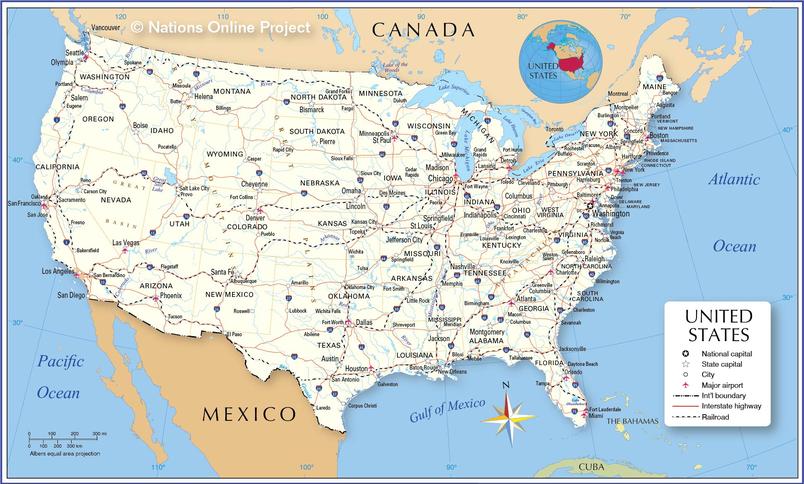
The United States struggled to establish a universal healthcare system throughout the 20th century due to a blend of historical timing, political power struggles, federalism complexities, and the rise of private insurance. Despite early attempts and clear models abroad, various forces kept the US healthcare landscape fragmented and resistant to a one-size-fits-all solution.
Let’s unravel this knotty story, piece by piece. We’ll see how ambitions got tangled with politics, how doctors and insurers wielded power, and why, even after decades, the US settled for a patchwork rather than a universal blanket of care.
The First Attempts: Early 20th Century Dreams and World Wars
Did you know that health insurance proposals appeared in the US Congress as early as 1916? Early progressives admired the German system, which Chancellor Bismarck had established decades earlier.
But timing was terrible. World War I sparked anti-German sentiments. Suddenly, adopting a “German” health system made for a tough sell. Both federal and state efforts fizzled out.
Fast forward a bit. Franklin D. Roosevelt wanted universal health as part of his New Deal. Yet, he prioritized old-age pensions first, reasoning that social security for seniors was foundational. Attempts continued – Robert Wagner initiated hearings in the late 1930s, only for World War II to overshadow health insurance talk. President Truman took another run in 1945, and later John F. Kennedy in 1963 tried to rekindle the flame.
Universal Health Care: A Moving Target With Many Meanings
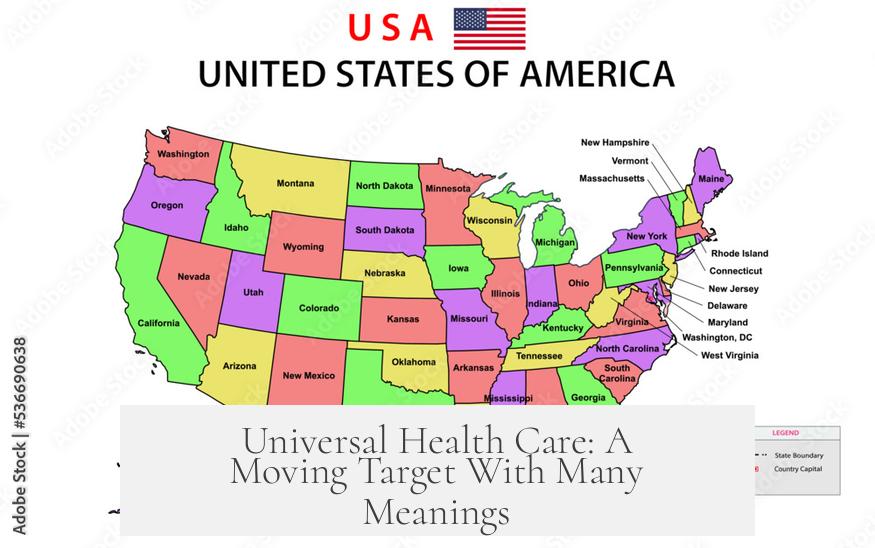
One huge challenge was agreeing on what “universal healthcare” meant. For some, it implied government-run health coverage for all. For others, especially as private health insurance exploded post-WWII, it meant everyone having some type of coverage—whether public or private.
This ambiguity made the goal slippery, like trying to hammer nails into Jell-O.
The Private Insurance Explosion and Federalism Headaches
During World War II, wage controls were tight, but there was a loophole: employer-provided health insurance wasn’t capped. Employers began offering health benefits to lure workers. By 1951, Blue Cross plans enrolled over 31 million Americans.
This growth made voters less panicked about healthcare access, because many were suddenly insured. However, gaps persisted for the elderly, poor, and disabled.
Meanwhile, federalism threw more curveballs. Should health insurance be federally managed or run by states? The US has a strong tradition of state control over things like health and education. Some progressive reformers worried that state mismanagement—seen earlier with unemployment benefits under Social Security—could doom a national plan.
So Congress faced a choice: lean into existing state infrastructures or build new federal systems that might provoke powerful state pushback. Nobody wanted extra bureaucracy, especially not with vocal opponents waiting.
The American Medical Association: The Ultimate Gatekeeper
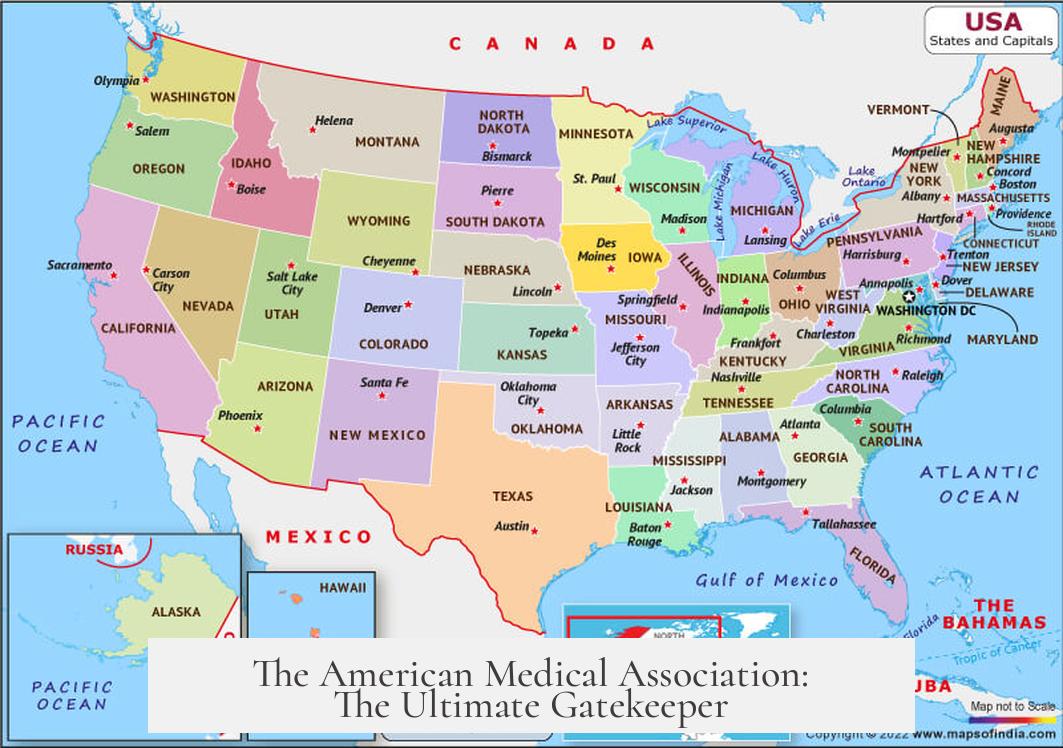
Enter center stage: the American Medical Association (AMA), staunchly opposed to any “third party” stepping between doctor and patient.
Doctors feared losing income if fees were controlled and resented increased oversight that health insurance bureaus could impose to catch fraud—an ongoing problem costing the US over $100 billion today.
AMA hired the savvy campaigners from Campaigns, Inc., whose 1933 political consulting firm had brought down socialist-leaning candidates before. Their strategy was brilliant: linking universal healthcare to the scary “socialized medicine” label, hitting all the right nerves during a politically charged era.
“The old-world contagion of compulsory health insurance…will mark the beginning of the end of free institutions in America,” declared AMA’s campaign Chief Clem Whitaker, stirring fears about socialism and loss of liberty.
This messaging worked wonders. AMA doctors continue to earn about twice as much as physicians in comparable countries and wield immense political influence.
Nixon’s Proposal and Bipartisan Sabotage
Sometimes history surprises with irony: President Nixon championed a health plan eerily similar to the Affordable Care Act—motivated by personal loss when his brother died young from a preventable illness.
However, Democrats, particularly Senator Ted Kennedy, pushed for a more expansive Medicare for All approach. This split bipartisan support, with each side blocking the other and leaving significant reform stalled.
Medicare and Medicaid: The Compromise Systems

By the 1960s, Kennedy and Johnson focused on incremental progress, leading to Medicare and Medicaid’s creation in 1965.
Medicare started as a national plan covering hospital care primarily, with doctor services added later. To overcome Senate resistance, the program allowed private insurers like Blue Cross to manage parts of it.
Medicaid was designed as a state-run program for the poor, building on earlier attempts targeting indigent elderly care.
Both programs were built to expand over time, potentially evolving into a broader universal system. Yet, despite occasional enthusiasm, political will for further expansion never solidified.
Legal and Constitutional Hurdles: Federalism in Practice
The US Constitution doesn’t explicitly authorize the federal government to provide healthcare. This ambiguity meant any full national health system faced legal uncertainties without a constitutional amendment.
Instead, the government acted through taxing power and general welfare provisions. Even Medicare participation isn’t technically mandatory for providers, but incentives and workarounds keep most doctors on board.
The Supreme Court barely upheld parts of the Affordable Care Act, citing taxing powers, illustrating ongoing constitutional tightropes.
International Comparisons: The US as the Outlier
Contrast America with its liberal democracy cousins. Germany pioneered health insurance in 1883 but took over a century to reach comprehensive universal coverage. Their journey was piecemeal and gradual, adding groups step-by-step, with universal coverage only firmly mandated in 2007.
Other countries like Taiwan and Israel only introduced universal health systems as recently as 1995—so the global trend isn’t necessarily “old news.”
Yet, the US approach remains unique because of its deep reliance on private insurers combined with patchy public programs, making universal healthcare more elusive.
Reflection: What Can We Learn From This Puzzle?
Why is all this history worth knowing? Because understanding why the US missed the universal healthcare boat helps explain present-day debates.
- The piecemeal development created a health system that’s costly, complex, and unfair.
- Strong political and professional interests can block reforms, even if broadly supported.
- Federalism can complicate national solutions but also tailor programs to local needs.
Would the US have fared better adopting a socialized health system early on? Maybe. Could gradual expansion of Medicare into a universal plan work? It has political momentum but faces entrenched resistance.
History shows that adopting universal healthcare isn’t just about good ideas—it’s about timing, politics, power, and persuasion.
Practical Takeaways for Today’s Readers
If you’re wondering what to do with all this info, here are some tips:
- Stay informed. Knowing the history arms you for better discussions about today’s healthcare debates.
- Understand terms. “Universal healthcare” can mean different things—clarify what’s being proposed in each case.
- Recognize political realities. Interest groups like the AMA have shaped policy for decades.
- Support incremental progress. Programs like Medicare and Medicaid proved that partial solutions can pave the way.
- Ask tough questions. How can federal and state systems best cooperate? What protections ensure quality care?
Final Thoughts
The US didn’t establish universal healthcare in the 20th century because of a complex web of historical timing issues, resistance from powerful groups, the rise of private insurance, ambiguous definitions, and constitutional challenges.
This story is a warning and a lesson. Change is possible but requires overcoming entrenched interests and uniting around a clear, shared vision. Meanwhile, America continues to patch together a system that leaves many uninsured or underinsured.
So, why didn’t the US establish universal healthcare earlier? It’s not one villain, but many factors, each playing a part in the ongoing saga of American healthcare.
Now, isn’t that a more interesting answer than some bland soundbite? If history is the teacher, then policymakers still have homework to do.
